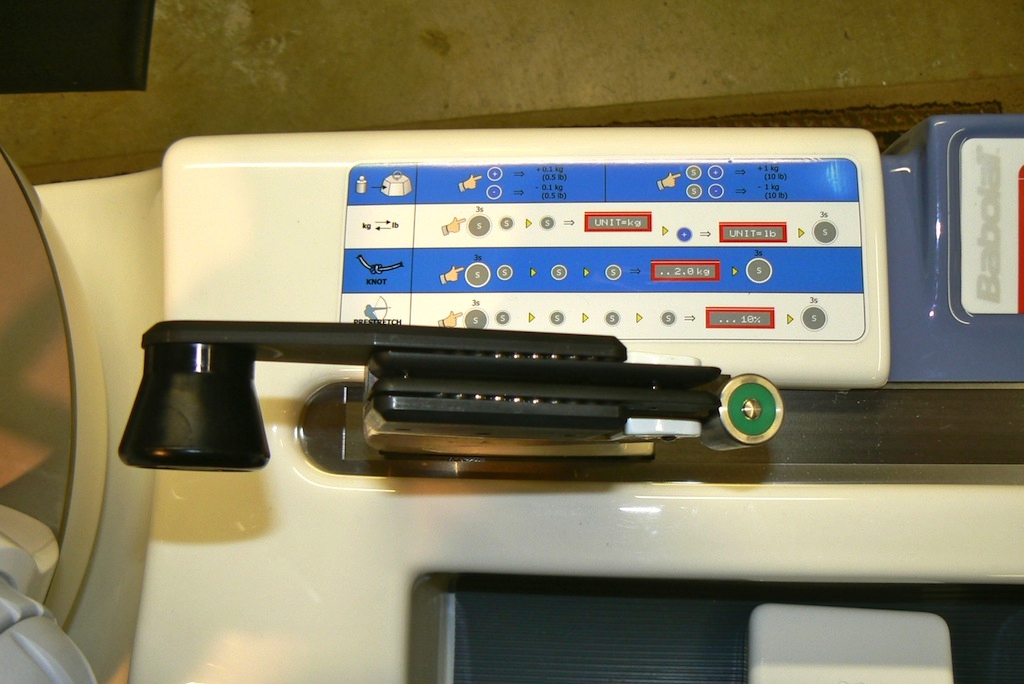The Diabolo-A History

After doing some research and contacting some valuable resources within the industry I was able to come up with some very interesting information on the Diabolo (many thanks to Lucien Nogues of Babolat). This, IMHO, was one of the more unique additions to the stringing world as we know it today. It occurred between 1960 & 1965 when the French company Spenle (Est 1945) was making stringing machines under the name of Spenle Pizzera (SP etc). They introduced the Dyna machine and brought the Diabolo to the stringing world. Spenle is now better known as the manufacturer of Tecnifibre stringing machines. Babolat Star 5 diabolo (above)

The idea is two-fold; to reduce the stress on the string in the string gripper or traction head by adding a device that would essentially absorb the lion’s share of the friction and pressure (compression) and to provide a linear path for the string to enter the string gripper. By wrapping the string around a grooved cylinder shaped like an hourglass you would be providing a first line of defense that would alleviate up to 70% of the stress on the string. According to Mr. G. Spenle, the concept is pretty old and probably adapted from sailing ships. He states “In the world of sailing there are many round and cylindrical parts that come into contact with the ropes used. The English “Bollard” pad which serves to tie up boats is a perfect example”. Take a look at the photo on the right of the mooring bollard. Notice how it resembles our modern-day Diabolo, only in half the form. We have the top end of an hourglass shape and this is what the rope is wrapped around to secure the ship to the dock. Since the ships are so heavy and the lines are so big, the mooring bollard relieves the stress on lines imparted by the weight of the ship.

What we have in a stringing machine is a concept that in essence, serves to reduce the stress on the string before it enters into the mobile jaws of the pulling unit. The Diabolo reduces the stress on the string and without the Diablo, the jaw itself would bear the entire load. Thus, the string would have a greater chance of being damaged. Most strings have a matrix of glue (bonds) or in the case of natural gut, collagen that holds the basic structure together. When those bonds are stressed the string integrity can be compromised. Take a look at the next photo of the Diabolo on the Babolat Star 5 machine (click on the image to enlarge it for a better look). Notice a resemblance to the mooring bollard? Babolat incorporates a Diabolo on the Star III as well as other models to serve the same purpose of protecting the string as sailors do when mooring ships. Stress is reduced and everyone is happy, especially the player whose string will now have better odds of good tension maintenance. Some earlier machines actually had contact points within the string gripper that activated the pulling mechanism once the string was inserted into the gripper. Using a Diabolo ensures that the string would come into perfect alignment within the gripper and in turn, activate the pulling mechanism.
For the record, I researched Wikipedia for a proper definition of “Diabolo” and found it interesting that in fact, they are correct when they say that many people miss-spell the word as “Diablo” instead of Diabolo, and to his credit, Mr. Nogues made reference to this during our communications. Check it out below:
The diabolo (commonly misspelled as diablo; formerly also known as “the devil on two sticks”) is a juggling prop consisting of a spool that is whirled and tossed on a string tied to two sticks held one in each hand. A huge variety of tricks are possible using the sticks, strings, and various body parts. Multiple diabolos can be spun on a single string.
Diabolos come in different shapes and materials. Diabolos with more weight tend to retain their momentum for longer, whereas small, light diabolos can be thrown higher and are easier to accelerate to high speeds. Rubber diabolos are less prone to breakage yet are more prone to deformations. More commonly used are plastic-rubber hybrids that allow flex but hold their shape. One-sided diabolos are also available but are more difficult to use
So whether you’re stringing a racquet or performing as a juggler the Diabolo is a useful little device. Certainly, its application to the stringing world has been an important addition as it pertains to maintaining the integrity of the string. So no matter how you “juggle” it, the Diabolo is a good thing and serves a very meaningful purpose in the stringing world. It’s a very practical and effective method of reducing the stress on the thing the player values the most-the string!
Credits: Lucien Nogues of Babolat for providing some of the information contained in this article.


Leave a Reply
You must be logged in to post a comment.